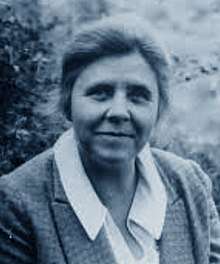Anna Johnson Pell Wheeler
Anna Johnson Pell Wheeler (May 5, 1883 – March 26, 1966) was an American mathematician. She is best known for early work on linear algebra in infinite dimensions, which has later become a part of functional analysis.[1]

Biography
Anna Johnson was born on 5 May 1883 to Swedish immigrant parents in Hawarden, Iowa in the United States. At the age of nine her family moved to Akron, Iowa and she was enrolled in a private school. In 1903 she graduated from the University of South Dakota and began graduate work at the University of Iowa. Her thesis, titled The extension of Galois theory to linear differential equations, earned her a master's degree in 1904. She obtained a second graduate degree one year later from Radcliffe College, where she took courses from Maxime Bôcher and William Fogg Osgood.[1][2][3]
In 1905 she won an Alice Freeman Palmer Fellowship from Wellesley College to spend a year at the University of Göttingen, where she studied under David Hilbert, Felix Klein, Hermann Minkowski, and Karl Schwarzschild. As she worked toward a doctorate, her relationship with Alexander Pell, a former professor from the University of South Dakota, intensified. He traveled to Göttingen and they were married in July 1907.[2][3] This trip posed a significant threat to Pell's life, since he was a former Russian double agent whose real name was Sergey Degayev.[2]
After the wedding, the Pells returned to Vermillion, South Dakota, where she taught classes in the theory of functions and differential equations. By 1908 she was back in Göttingen, working on her dissertation; an argument with Hilbert, however, made its completion impossible. She moved with her husband to Chicago, where she worked with E. H. Moore to finish her dissertation, Biorthogonal Systems of Functions with Applications to the Theory of Integral Equations, and received a Ph.D. in 1909.[2][3][4]
She began looking for a teaching position, but found hostility in every mathematics department. She wrote to a friend: "I had hoped for a position in one of the good univ. like Wisc., Ill. etc., but there is such an objection to women that they prefer a man even if he is inferior both in training and research".[5] In 1911 her husband suffered a stroke and she, after teaching his classes at the Armout Institute for the remainder of the semester, accepted a position at Mount Holyoke College. She taught there for seven years.[3][5]
In 1917, her last year at Mount Holyoke College, she published (together with R. L. Gordon) a paper regarding Sturm's theorem.[6] In that they solved a problem that had eluded J. J. Sylvester (1853) and E. B. Van Vleck (1899). That paper (along with their theorem) was forgotten for almost 100 years until it was recently rediscovered.[7]
In 1918 she became an associate professor at Bryn Mawr College in Pennsylvania. Three years later she became the head of the Bryn Mawr mathematics department, and became a full professor in 1925. In the same year she married a colleague named Arthur Wheeler, who soon went to Princeton University. She moved with him, commuting to Bryn Mawr, teaching part-time, and becoming active in Princeton's mathematics society. In 1927 she became the first woman to present a lecture at the American Mathematical Society Colloquium.[8] After Wheeler died in 1932, she returned to Bryn Mawr and taught full-time.[3][5]
Wheeler was instrumental in bringing German mathematician Emmy Noether to Bryn Mawr in 1933, after the latter's expulsion from the University of Göttingen by the Nazi government. The two women worked together happily for two years, until Noether died suddenly after an operation in 1935. Wheeler continued teaching at Bryn Mawr until she retired in 1948.[3] She died in 1966 after suffering a stroke.[5] Her doctoral students included Dorothy Maharam and Marion Cameron Gray.
References
- Louise S. Grinstein and Paul J. Campbell, "Anna Anna Johnson Pell Wheeler: Her life and work, Historia Mathematica 9(1982)37-53
- Kimberling, Clark. "Emmy Noether and Her Influence". Emmy Noether: A Tribute to Her Life and Work. Ed. James W. Brewer and Martha K. Smith. New York: Marcel Dekker, Inc., 1981. ISBN 0-8247-1550-0. pp. 3–61.
- O'Connor, J.J. and E.F. Robertson. "Anna Johnson Pell Wheeler". The MacTutor History of Mathematics archive. January 1997. Retrieved on 10 April 2008.
- Kimberling gives the year of her Ph.D. as 1910.
- Riddle, Larry. "Anna Johnson Pell Wheeler". Biographies of Women Mathematicians. 23 May 2007. Retrieved on 10 April 2008.
- A. J. Pell and R. L. Gordon:The Modified Remainders Obtained in Finding the Highest Common Factor of Two Polynomials. Annals of Mathematics, Second Series, Vol. 18, No. 4, 188--193, 1917
- Akritas, Alkiviadis G.:Anna Johnson and Her Seminal Theorem of 1917. Computer Tools in Education, Vol. 2, 13--35, 2016.
- "Prizes, Awards, and Honors for Women Mathematicians". agnesscott.edu. Retrieved 2014-01-25.
External links
- "Anna Johnson Pell Wheeler", Biographies of Women Mathematicians, Agnes Scott College
- Biorthogonal Systems of Functions (Abstract)
- Green, Judy; LaDuke, Jeanne (2008). Pioneering Women in American Mathematics — The Pre-1940 PhD's. History of Mathematics. 34 (1st ed.). American Mathematical Society, The London Mathematical Society. ISBN 978-0-8218-4376-5. Biography on p. 633-638 of the Supplementary Material at AMS